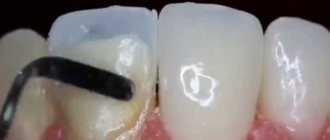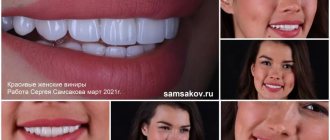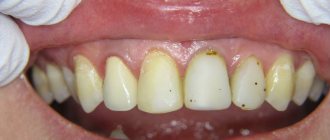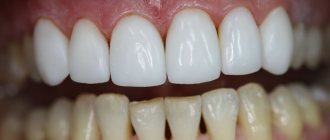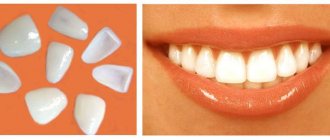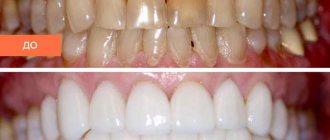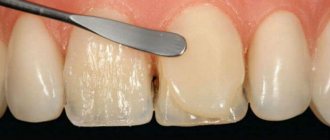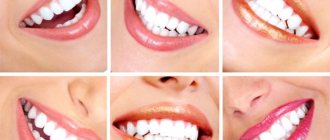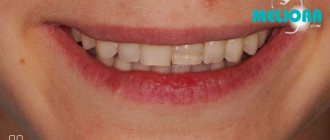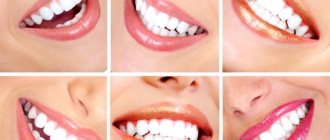Removable veneers – what are they and how to use them? How justified is such a purchase?
In pursuit of a flawless smile, many are often tempted by the advertising promises of manufacturers of inexpensive removable veneers. In such cases, most often we are talking about budget cosmetic mouthguards made of plastic or sets of template plates, which you need to attach to your teeth yourself using dubious glue from the packaging. Both options have many significant disadvantages. Therefore, in today’s article we will talk in detail about whether it is possible to insert removable veneers yourself and whether they are worth using at all.
Removable veneers - what is this design and what are its features?
What are removable veneers really?
So-called removable veneers have nothing to do with real ones. When describing this method of quick cosmetic smile restoration, it would be inappropriate to ask questions about which doctor places such veneers and whether it hurts to place them at all. The fact is that most often this term refers to cosmetic removable mouth guards, which are put on the entire dentition at once and, in theory, thus transform the smile. In practice, everything is completely different.
Such designs usually have template sizes, so they simply do not fit in most people’s mouths. And even if you manage to capture them, you definitely won’t be able to talk to them normally, much less chew food.
There is another variety - again, template linings for each tooth. Such plastic plates are sold in sets of 70 pieces at a time, with a brush, tweezers and special glue. However, no one knows how safe the composition of this glue is. And such “veneers” are unlikely to look natural and beautiful on the teeth. Therefore, experts in the field of aesthetic dentistry strongly do not recommend the use of such products, since they can not only be useless, but even harmful to the tissues of the oral cavity and the body as a whole.
Price
The price for composite veneers is 7,000 – 17,000 rubles, per 1 tooth (this is a turnkey cost). When setting the price, the condition of the dentition, the volume of intervention, and the reason for microprosthetics are taken into account. Also, the cost of direct veneering per tooth depends on the positioning of the clinic, material, method, and complexity of the restoration work.
Free online consultation with a dentist
| Service | Price |
| Installation of composite veneer | from 15,000 rub. |
Consultation and diagnostics are free!
All prices Promotions
Types of temporary microprostheses, including preparation and creation of impressions
What types of removable veneers are there?
- temporary plates - such plastic overlays are installed by the doctor in the dental office, after preparing and preparing the teeth for the installation of permanent structures. They will need to be worn until permanent ceramic or, for example, zirconium plates are ready. By the way, many people are interested in the question of how old people are to get veneers. So, a similar procedure is performed on patients at least 18 years of age,
- removable template mouthguards and overlays - you can buy them on the Internet, pharmacy or cosmetics store. However, they are really of little use - neither cosmetic mouth guards nor overlays with a cheap adhesive composition will stick to the teeth for a long time and reliably. Moreover, they can damage the enamel and mucous membranes, provoke inflammation,
- individual removable Snap-On Smile - such cosmetic prostheses are made from impressions exclusively in the laboratories of the American company DenMat in the USA or Europe. That is, in a Russian clinic you can undergo all the preparatory procedures, but you will have to wait about a month for the arrival of the finished plates. Such designs, by the way, also allow you to disguise missing teeth. However, experts do not recommend wearing them on a permanent basis - this is an acceptable option as a temporary measure.
Is it possible to install veneers without damaging the enamel?
If we talk exclusively about removable aesthetic mouthguards, then standard polymers, silicone, polypropylene and other types of plastics of appropriate shades are usually used for their manufacture. All these are inexpensive materials that can be easily processed and painted. Such structures are installed in the oral cavity without any grinding of teeth or taking impressions. However, due to their standardized size, such structures practically do not stay in the oral cavity; it is impossible to speak normally with them, chew food, or even smile.
On a note ! There is a separate type of cosmetic removable dentures Snap-On Smile. They are made individually for each patient, so they require preliminary impressions. The development belongs to the American company DenMat, so the prostheses themselves are created in the laboratory of the manufacturing company. Such onlays stay in the mouth much better and allow you not only to transform the aesthetics of your smile, but also to visually restore missing teeth. However, this option can only be considered as a temporary solution. Read more about Snap-On Smile dentures in our separate article.
However, temporary onlays can also look like real classic ones, that is, one thin plate for each tooth. In dentistry, such products are usually made of plastic and fixed with temporary adhesive until full-fledged microprostheses made of ceramic or, say, zirconium are ready. In this case, preparation and making impressions are an integral stage of smile restoration.
What if you choose subtle options?
Sometimes, when choosing ultra-thin plates, for example, “Lumineers” from the same DenMat company, it is possible to completely avoid turning the living enamel, but here we are talking about full-fledged permanent veneering. On sale you can find cheap template analogues - plastic overlays in a set with glue of dubious quality. Such products cannot be of high quality and, as noted above, it is better to avoid them so as not to harm the enamel and gums
What glue is used to install removable veneers and its features
So-called removable veneers, which look like mouth guards, are simply placed on the teeth. To secure them, no adhesive compounds are needed. Although we cannot talk about any reliable fixation in the case of template cosmetic prostheses. No complicated instructions for their use are required either.
The removable plates, which follow the shape of the teeth and are sold in packs of 70 pieces, have a template shape. They are attached using a special glue that comes in each set. The kit usually also includes a special brush and tweezers. But if professional dentistry uses proven compounds, then in this case it is not entirely clear what exactly the composition of the glue is and how safe it is for the body. Therefore, dental experts strongly recommend not to risk your health.
Classic non-removable products are fixed with a special heavy-duty adhesive; subsequently, you will not be able to remove them yourself. But for Cerinate (DenMat) lumineers they use a special patented adhesive composition, which additionally has protective properties for the enamel[1].
Color of ceramic cladding
The colors of ceramic veneers are determined according to the standard Vita scale, which includes 16 main shades and 4 additional ultra-bright shades (Bleach). This scale involves division according to two principles: tone and brightness. four types of ceramic cladding colors :
- A – red-brown color;
- B – red-yellow tint;
- C – gray shade;
- D – gray-red color.
Each type is also divided into 4 groups according to brightness. Thus, ceramic veneers A1 are lighter than A2, which, in turn, are lighter than A3. A4 is the darkest of this group; shades B, C, D are divided similarly. Additionally, the brightest shade of Bleach ceramic veneers, which is not found in nature, is distinguished. This color of veneers is the most popular; it is the one most often used to make veneers for stars.
Fixed plates - indications and installation
But let’s return to the question of what veneers and lumineers are in the classical sense. We are talking about very thin overlays that are fixed on the front side of the front teeth in order to hide their aesthetic defects, that is, to correct the shape and size of incisors and fangs, to disguise too large gaps between the teeth, to give the enamel a beautiful snow-white shade and vibrant shine. After such a procedure, your smile can be transformed beyond recognition.
In their classic form, veneers are immediately recognizable
The plates themselves are made from durable and aesthetic materials, most often from pressed ceramics or zirconium dioxide. There is also the option of more budget-friendly composite plates. By the way, with the help of a composite, teeth are literally grown in a direct way - the front surface of the incisors is covered with a photopolymer and immediately illuminated with a polymerization lamp, that is, all manipulations are carried out directly in the patient’s oral cavity.
If we talk specifically about the indirect method, then the thickness of one such structure usually varies from 0.6 to 0.8 mm. Therefore, before installing microprostheses, the doctor first grinds off a small layer of enamel in order to preserve the anatomical parameters and aesthetics. Each plate has a small protrusion at the base, which, after fixing the product, neatly overlaps the cutting edge, which increases its strength and improves other performance characteristics.
“When I was getting veneers, I agreed to have them trimmed myself, but honestly, I didn’t think that so much would be removed! I almost cried when I saw my smile after the dissection. Thank God they gave me removable plastic pads, otherwise I don’t know how I would have walked. With plastic ones, of course, it’s not very convenient, but what can you do? Now I’m waiting for my ready-made teeth to arrive from the States.”
Vikki, review from the women's forum woman.ru
But there is another option - ultra-thin plates with a thickness of 0.2-0.3 mm. The most popular brand that produces these types of pads is the Lumineers brand, which belongs to the DenMat company. To create ultra-thin plates, they use a special patented material called Cerinate, which is both highly durable and almost flawless in aesthetics. In some cases, when choosing ultra-thin onlays, it is possible to completely avoid grinding your living enamel.
Fixed plates are installed in patients using approximately the same algorithm. The universal sequence of actions is briefly described below:
Although turning the enamel is not always necessary, it is still one of the stages of action
- preparation, including treatment of carious cavities, replacement of old fillings, anti-inflammatory therapy if necessary, removal of plaque and deposits, selection of the shade of future restoration using the Vita scale,
- turning the enamel - removing a small layer of living hard tissue so that after installing the plates, the teeth do not look too voluminous and massive,
- making impressions or 3D scanning of the internal structures of the oral cavity,
- conducting photometry – fixing photoparameters of facial symmetry,
- bite modeling on an articulator or using advanced digital smile design software,
- installation of temporary plastic overlays to protect ground incisors and canines and temporarily hide aesthetic defects.
Once the permanent products are ready, it is time to remove the temporary overlays. Finished permanent veneers are attached using a special heavy-duty adhesive composition.
Classic non-removable plates are the best option if you want to get a highly aesthetic and durable result. Any removable structures aimed at aesthetics are acceptable only as a temporary measure, and many of them are not suitable for use at all, being only a product of an advertising gimmick.
Manufacturing Features
Depending on the type of veneers, the methods and features of their manufacture have some distinctive features. In order to choose suitable products, you should carefully consider the options for making ceramic and composite veneers.
Ceramic veneers
The technology for manufacturing ceramic veneers provides several options:
- During the first method, ceramic material is applied in layers, which are subsequently fired. Using this method, unpressed ceramics are produced;
- The second method produces pressed ceramics. During manufacturing, the casting is formed under high temperature. Unlike non-pressed records, these products have an increased service life.
Veneers are tightly bonded to the tooth surface and have optical, mechanical and biological properties the same as human tooth enamel. This is what made ceramic veneers popular in dental restoration.
Features of installing ceramic veneers:
- First, the tooth is ground down; this is required for further installation of veneers;
- Next, a special mixture with a fast-acting structure is applied to the surface of the teeth. An impression is made from this mixture, with the help of which the future microprosthesis is created on a computer;
- after this the grinding and production of plates is carried out;
- The inner surface of the veneers is processed with a special tool, which is designed to apply a surface with a rough structure. This is required for better adhesion of the plate to the teeth;
- during the production of veneers, temporary microprostheses are installed on the surface of the teeth;
- When attaching permanent laminates, temporary ones are removed. Installation of permanent veneers is carried out on a cement mixture
Features of manufacturing composite veneers
The production of composite veneers is carried out using two technologies:
- During the first method, composite microprostheses are made on site in the dentist's office. These products are typically referred to as direct or therapeutic. During the procedure, the doctor removes the top layer of enamel. Next, a light-polymer material is applied to the surface in layers. The surface of the teeth is gradually restored, and all damage and defects are corrected;
- During the second method, the plates are produced in a laboratory. Before production begins, the enamel is removed from the surface of the teeth and an impression is taken. A composite veneer is made based on the impression.
Composite veneers are made directly in the patient's mouth from composite materials by applying them layer by layer. The technology of composite veneering is similar to artistic restoration of teeth.
Description of veneers made of composite materials
Composite veneers have recently begun to be in low demand; reviews from many patients reveal many negative qualities. Many dentists recommend using composite plates that are made in a laboratory because they are much better and stronger than products that are made right in the dentist's office.
Important! In 90% of cases, the veneers used are those that are applied by the dentist directly in the office. Typically, a layer of composite material placed on the front of the teeth looks like a large filling that costs much more than a typical dental restoration.
When installing veneers in the office, the doctor grinds the incisors and applies a layer of material. Then the technician uses special laboratory equipment to give it the required color and transparency.
Direct method of making veneers in the oral cavity: the doctor assesses the condition of the teeth - the color of the composite material is selected - the teeth are ground - a veneer is formed from composite materials - the veneer is ground and polished.
How many teeth can veneers be placed on?
When answering the question of how veneers are placed, you should immediately pay attention to the fact that this kind of restoration plates are fixed only on the front teeth on their front side. By the way, such onlays are also placed on crooked teeth, but only when they have slight curvature. Usually they are recommended to be attached to all incisors and canines that fall within the smile zone, and these are 10 front upper and 8 front lower teeth. Veneers are placed using a special technology, so only an experienced specialist can install them correctly. The use of this restoration method allows you to make a Hollywood-style smile snow-white and irresistible.
Your future smile is worth all the effort
When to use
The list of indications for the installation of composite veneers includes:
- irregularities present on the front units;
- chips;
- enamel microcracks;
- large interdental spaces;
- discoloration that cannot be bleached.
Typically, the described technology is used if you need to correct the appearance of one or two teeth. There is never any talk of large-scale work involving the use of a composite. If there are multiple defects, gluing ceramic overlays is considered a more rational way to eliminate them.
